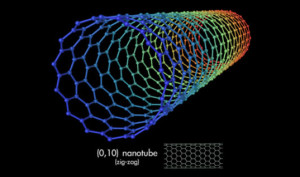 In a little booth tucked in the corner of this week’s SC13 supercomputing conference may be the next Intel.
In a little booth tucked in the corner of this week’s SC13 supercomputing conference may be the next Intel.
There you’ll find Max Shulaker, a Stanford University graduate student, ready to explain carbon nanotube digital circuits to anyone stopping by. Shulaker is part of team of researchers building such circuits, and will be presenting to attendees their research on “the first” computer built using carbon nanotubes, or CNTs.
The Stanford research team has emulated the MIPS instruction set, making it programmable. “Everything we do is silicon compatible,” said Shulaker.
The result is 10x benefit in a metric that considers performance and energy. In short, it’s a big leap over silicon.
Supercomputing users are relentless in their pursuit of compute power so they can run simulations of increasing complexity and scale to tackle mankind’s truly big problems. But Moore’s Law, once a reliable predictor of computing power’s future, has reached its limits.
Supercomputing researchers aren’t sure what’s next.
Today, supercomputing relies on architectural changes, such as adding speedy GPUs, to boost performance. Researchers may increasingly turn to chips that integrate interconnects and memory to speed processing and reduce energy.
But the teams must also wrestle with the enormous costs of building – and running – multi-petaflop systems.
“We have reached the end of the technological era,” said William Gropp, chairman of the SC13 conference and a computer science professor at the University of Illinois at Urbana-Champaign.
Gropp likened the supercomputer development terrain today to the advent of CMOS (complementary metal oxide semiconductor), the foundation of today’s standard semiconductor technology. The arrival of CMOS was disruptive, but it fostered an expansive age of computing.
“The problem is we don’t have a technology that is ready to be adopted as a replacement for CMOS,” said Gropp. “We don’t have anything at the level of maturity that allows you to bet your company on.”
But change will arrive, and it will likely be disruptive.
In switching from standard semiconductor technologies, there’s “no reason to believe that the same companies [leading the industry] now will necessarily have the big advantage,” said Peter Beckman, a top computer scientist at the Department of Energy’s Argonne National Laboratory, and head of an international exascale software effort.
“Next generation technologies may come from companies working with innovative materials that are not anywhere near silicon, like the carbon nanotubes,” Beckman said.
“In the meantime, though, unless something fundamentally improves or changes, we’re going to have this plateau in our technology,” he said.
Supercomputer users have become constrained by power limitations and money, said Beckman. Large supercomputer system prices have topped off at about $100 million “so performance gains are not going to come from getting more expensive machines, because these are already incredibly expensive and powerful. So unless the technology really has some breakthroughs, we are imagining a slowing down.”
A carbon nanotube is essentially a rolled-up sheet of grapheme that forms a nanocylinder with a diameter of about one nanometer. You can fit 10,000 carbon nanotubes side-by-side and it would still fit within a single human hair, said Shulaker, who is working at Stanford with Professors Subhasish Mitra and Philip Wong.
This Stanford team synthesized their own nanotubes by taking a quartz wafer and adding iron nanoparticles and then heating it to 1,652 degrees Fahrenheit. The resulting CNTs become the channel for the transistor, which are turning on and off.
“I’m really interested in things like emerging technologies because I want to know if CNTs are going to be able to save us in time,” said Gropp.





